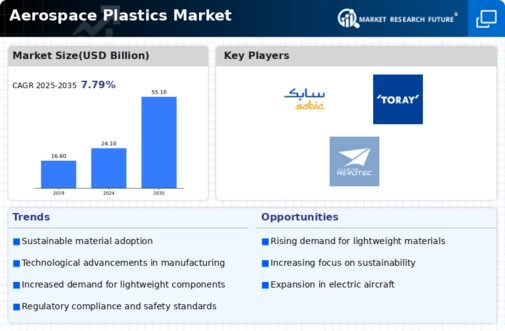Market Share
Aerospace Plastics Market Share Analysis
In the fiercely competitive realm of the Aerospace Plastics Market, companies strategically deploy diverse market share positioning strategies to establish a robust presence and gain a competitive edge. A fundamental strategy involves differentiation, where companies focus on producing high-performance aerospace plastics with unique characteristics, such as lightweight properties, high strength-to-weight ratios, or resistance to extreme temperatures and chemicals. By investing in research and development, companies can create innovative formulations that cater to the stringent requirements of the aerospace industry, setting themselves apart from competitors and securing a significant market share. Differentiation not only attracts aerospace manufacturers seeking advanced materials but also enhances the overall perceived value of aerospace plastics in the market.
Cost leadership is another pivotal strategy employed by companies in the Aerospace Plastics Market. This approach revolves around becoming a low-cost producer through optimized manufacturing processes, economies of scale, and efficient supply chain management. Emphasizing cost efficiency enables companies to offer competitive pricing for their aerospace plastics, making them appealing to cost-conscious aerospace manufacturers and gaining a larger market share. The successful execution of this strategy demands continuous improvement, innovative production methods, and a keen focus on operational excellence to maintain profitability while providing cost-competitive materials.
Strategic alliances and partnerships play a crucial role in shaping the market share positioning of companies in the Aerospace Plastics Market. Collaborating with key stakeholders such as aerospace OEMs (Original Equipment Manufacturers), material suppliers, or research institutions allows companies to access essential resources, cutting-edge technologies, and distribution channels. Through strategic partnerships, companies can expand their market reach, leverage shared expertise, and create synergies that enhance their overall competitive position. This collaborative approach fosters innovation, accelerates market penetration, and contributes to a more robust market presence.
Geographical expansion is a strategic imperative for companies aiming to increase their market share in the Aerospace Plastics Market. Identifying and entering new markets or expanding existing operations globally allows companies to tap into regions with growing demand for advanced aerospace materials. Adapting products to suit the unique requirements of different aerospace markets is crucial for success in geographical expansion. This strategy enables companies to diversify their customer base, reduce dependency on specific regions, and strengthen their market share on a global scale.
Furthermore, a customer-centric approach is indispensable for gaining and maintaining market share in the Aerospace Plastics Market. Understanding the specific needs of aerospace manufacturers, providing technical support, and offering excellent customer service contribute to building strong relationships. Companies that prioritize customer satisfaction often benefit from increased loyalty, positive word-of-mouth marketing, and repeat business, ultimately solidifying their market share. As the aerospace industry continues to evolve with increasing demand for fuel-efficient and lightweight materials, aligning products with customer expectations becomes crucial for sustained success in the Aerospace Plastics Market.






Leave a Comment